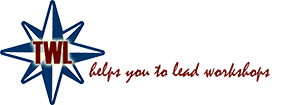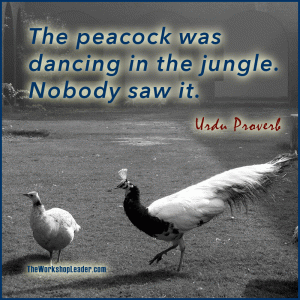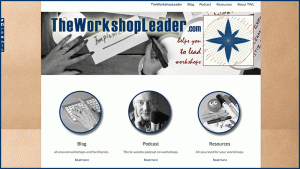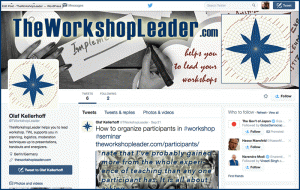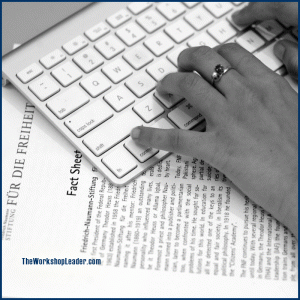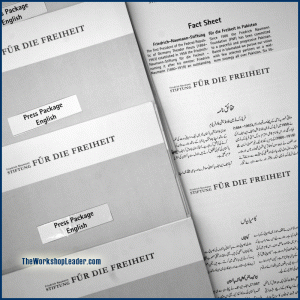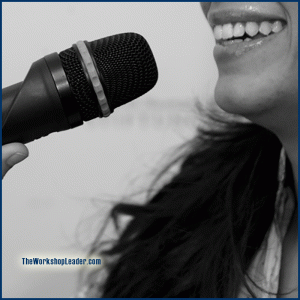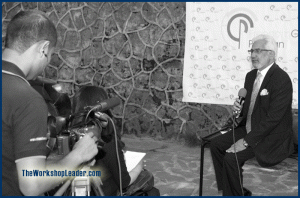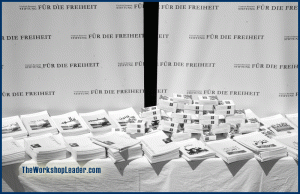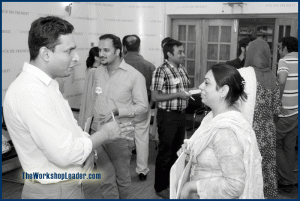The peacock was dancing in the jungle. Nobody saw it.
Urdu Proverb
Event Marketing is an integral part of event management. Even if you have enough participants it is a very good idea to use every occasion to brand your organisation as well as to spread your message.
You should be doing this before the workshop begins as well as after it. Or as the German soccer player and manager Sepp Herberger (1897—1977) said, ‘After the game is before the game.’ Your next workshop will come and more people will have heard about you. If people say good things, then potential participants are more likely to join.
Most of the tools and channels of communication addressed below do not involve investments of money, simply time. Allocate enough time in your preparation phase!
You should choose the appropriate tools and channels of communication on the basis of your Target Audience Analysis.
Corporate Design
Corporate Design (CD) is part of the Corporate Identity (CI) of an organisation. This is how the organisation is perceived, what it stands for and how it communicates. CD is the visual part of internal and external communication. You should apply the principle that form follows function: products must be useful and easy to handle, but nonetheless recognisable. The recognisability is created by the use of a logo, font, colours and proportions etc.
In order to brand yourself and to be recognisable, all your products should feature the same elements. This includes your invitations, Participant List, certificates and banners, etc. The effect is created through repetition, repetition, repetition.
This blog or the E-book, for example, uses the CD of TheWorkshopLeader.com: the logo is there, the font colour is defined and remains consistently the same (font, border of photos and other layout elements). So, after a short while it’s recognisable wherever you look at: E-Book, YouTube channel, Facebook community etc.
It helps your branding, as well as the orientation of participants, when the banner image or the whole banner is used on the Program, in any online communications including emails, printed invitations and so on.
My Message — AIDA
The AIDA principle has been a basic marketing tool for at least a century. Every TV spot or radio message employs it. Every billboard or poster is based on it. Every brochure or homepage applies it — and if not, they fail to deliver the expected results. AIDA is simple, effective, and applicable to all marketing projects. It is an acronym for:
Attention Interest Desire Action
Attention: The precondition that somebody sees your message is that she or he sees, listens, or watches the advertisement or event announcement. Accordingly, you have to attract attention. This gets harder and harder in a world in which people are constantly bombarded by information and messages. You have to break through the wall of noise. You can attract attention by using an unusual picture [see Photography], an unusual video or an unusual sound bite.
Interest: Once someone notices your advertisement, he or she must be motivated to read or watch it. The first sentence needs to be short, concise and attractive. You need to pitch your language and register according to your target audience, i.e. your participants. It’s useful to have key words and topics that will appeal to your participants.
Desire: It is not enough just to have someone read your message. Why should he or she come to your event? Why should someone leave his or her comfort zone? What will move him or her? The answer is desire. Without some perceived personal benefit it is unlikely that you will convince anyone to act. And as everybody is motivated by different factors, it is a very good idea to base your promises on the strengths and weaknesses of your target audience [see Communication/Target Audience].
Action: Even if you have achieved the three preceding steps, people often forget to direct their audience to a specific course of action. This means that all their efforts in attracting attention and arousing desire will have been in vain. You will need to guide your audience to do something specific. What should a possible participant do?
5Ws
Your announcement should always contain the famous five Ws:
- When does it take place?
- Where is it?
- What is it about?
- Who should apply?
- Why is it worth participating?
Be precise and guide the action thoroughly in order to avoid extra work for yourself in the form of unnecessary phone calls or email enquiries! [To adjust your message better: aCommunication]
Homepage
A homepage is the backbone of your company’s or organisation’s communication with your target audience. Your website should give basic information about your personal or organisational background. It should also provide an opportunity to get in touch with you. Importantly, it also acts as a shop window for your current activities — if you fail to update, it suggests to the casual observer that your organisation is inactive. Don’t neglect it!
Details of every event that you have organised should be outlined here in the form of a small report with one to three photos. You will find tips for writing web articles below. This is the place to announce future events and to call for applications. The event announcement comprises the 5Ws [anext section]. Don’t forget to take the announcement from your website once the event is over!
Social Media
Social media offers huge opportunities for you to network as well as to promote your activities. As with your homepage, social media is an opportunity to announce your events as well as to report those, which have already happened, but using slightly more informal language than a homepage. It is best to
write short, pithy captions to accompany pictures rather than lengthy chunks of text. To accompany the announcement it’s useful to create a Facebook Event. Again, nice pictures and a few interesting lines will attract attention, generate interest and — with luck — make people want to attend. In social media messaging, the proposed action should still be guided according to the principle of the 5Ws [see AIDA].
Web 2.0 (social media as opposed to the previous static Web 1.0 like a website) is interactive. This means that you can and should engage with your audience in the form of messages, comments and likes. People can recommend your events to their friends who can pass it on to a wider network of people. This means that your messages will go viral if your content is attractive.
You should remember that once you decide to get involved in social media it becomes an obligation: your friends and supporters will expect updates, answers and reactions. There is no point in having an account and not interacting with it. This can become very time consuming. We would suggest that you use your time sensibly but make sure that you do not neglect social media.
Press Invitation
Sometimes, I hear NGOs complaining that they don’t get any press coverage. Of course they blame journalists, media companies and overall the corrupt system. They never consider that it might have something to do with their own failures. Personally, I have experienced the opposite: generally media is open-minded and willing to cover your event — if you stick to some basic rules.
First of all, Public Relations (PR) is about having a relationship as the name indicates. Building up a relationship takes time and trust. You should not expect a reporter to come on your first call — they are not your employees who will act on your request.
Second, a journalist needs to be shown that there is some benefit in coming before he allocates some time in his busy schedule. Don’t forget to emphasis that there is a personal benefit. A journalist, like any other person, wishes to be respected and taken seriously. As media people often receive quite a lot of exposure, the level of attention they receive is often higher than that of people outside the public eye. Take that into account! Be gentle, respectful, and respect them and their work.
Third, there must be a benefit for the job! The results must be worth the time spent. That means there must be interesting photos to take, as well as good and interesting content. Any superlative is always a good hook: the first, the last, the biggest, the smallest, the most exciting. But stick to your promises, otherwise you lose trust and the journalist won’t come the next time.
High-profile guest speakers often provide an excellent reason to come. A journalist’s interest in the high-profile guest may be connected to something other than the workshop, but it’s an easy occasion to meet them without the hassle of setting up an interview. Take adequate steps to make an interview possible.
Fourth, make it easy for them. The invitation must clearly state the timings and venue. The best method is to send a Programme along, so that an interested journalist can decide when to come. Don’t expect them to stay for the whole event — unless it’s a training course for journalists! Providing a map should help make it easy to find the venue. Provide the details of a contact person (including mobile number) for questions in advance. Give them a hook early on by suggesting a news angle or providing a teaser text. A factsheet on your organisation or company along with profiles of the speaker as well as a press release eases his or her writing – and is your opportunity to influence the outcome!
Press Releases
A Press Release is the classic tool of Public Relations (PR). Companies, institutions and organisations send them out mostly in electronic form — email or fax. Nonetheless, printouts should be available at your event, too.
Hundreds of press releases might reach an editor’s inbox every day. Therefore, you should ensure that yours is a careful balance between serious content and eye-catching headlines. A Press Release is an integral part of your Corporate Design. They should always follow a standard template, which incorporates your organisation’s branding to ensure that they are instantly recognisable.
The line spacing should be 1.5—2 and a large indent in order to enable editors to write on them directly and thus partially reuse your text in their article. Because many journalists are too lazy or don’t have the time, they often reproduce, i.e. copy&paste, press releases. This provides an opportunity to you for having exactly your wording printed in the newspaper.
Furthermore, press releases should include all possible contact details. Journalism is a speedy business and editors may have to reach you immediately.
The content has to include all 5Ws [aAIDA]. Make the wording short and precise. The language should be interesting, too [For further tips: aWeb Article].
It’s recommended that you have other material from the workshop available for journalists, too, including transcripts of speeches, handouts and presentations.
Emails are free. But this doesn’t mean they don’t have value. Quite the opposite — by creating different mailing lists based on areas of interest you will be able to invite all the relevant people you know with
ease. This is known as direct marketing by which you directly approach a narrow target audience.
Some software programmes also allow you to send mass emails in a personalised way: ‘Dear Mr Smith…’ reads better than the more generic ‘Dear Sirs’.
Furthermore, you can send a brief report with pictures or a link to a report on your homepage after the event.
Mailing Lists are also useful for sending your electronic newsletter, which contains updates and news for your subscribers.
SMS
Short Message Service (SMS) provides another opportunity to advertise your workshop or to brand yourself. Often mobile service providers offer a certain amount for free and it is possible to find a special rate for sending bulk SMS.
You can send them like emails either to a mailing list you have created on basis of your contacts, or purchase addresses from a provider if you really want to reach out to the masses.
Due to the format the text has to be very concise, but nonetheless appealing and using all the 5Ws [see AIDA].
Unlike electronic media, producing printed material inevitably costs money. However, it can be worthwhile. Several formats are possible — the effectiveness of each of them again depends on the target audience.
Before an event
- Flyers are little print products you distribute in streets. This can be very relevant if you want to attract people who are living nearby.
- Brochures can be distributed, but also sent to people’s offices or houses. In comparison to handouts, they consist of several pages, often in colour and with photos and with more sophisticated text. The costs can be justified if you have a series of events that you wish to be highlighted in one impressive-looking document.
- Posters can be put up in a certain area (shops, trees, offices) if you want to attract people who live or work nearby or sent to a certain mailing list if you are targeting a specific group, e.g. students. In this case it would work to send them electronically to students and also have them hung around campuses.
- Billboards are another form of print and are more costly as the companies providing the advertisement space want to make a profit. Billboards are useful if you aim to attract a wider audience in a city.
- Stickers are another possibility for spreading your message. As they stick for a long time we would not use them for a single event. However, they are good branding tools.
After an event
- Conference Report: This is a good way of summarising the results of a conference or workshop and for making it accessible to a wider audience. These reports can be based on seminar minutes (of what was said) or on transcripts of the various lecturers. If you want to reduce printing costs, you could upload the report as a PDF file on your homepage and email it.
- Article: It may seem daunting, but you can write your own news articles and submit them to newspapers as well as magazines. If you are not sure about what you are doing, have them checked by more experienced friends. Deliver two or three meaningful photos along with your article (avoid group pictures of those who attended the workshop — few things are more boring).
- Annual Report: If your organisation publishes an Annual Report your events should be part of it. Showcasing the different activities you have organised throughout the year proves that the organisation is active.
Audio
To buy airtime — to pay for radio and TV advertisements — can be a very expensive option. Additionally, there are significant production costs involved. But you can turn it around by asking radio stations to cover your event or try to have yourself invited to the studio for an interview. As always in Public Relations your interaction should never just be a flash in the pan. Relations have to be built up and constantly nurtured. It sounds like a lot of effort but it will pay off in the end.
And have you built up your own podcast channel? Why not considering it? Of course not for a single event, but if you offer series of events, if you have company or a NGO doing workshops on regular basis and if you have other messages to share. Tune in mine, the TWL Podcast, and hopefully get persuaded 😉
Audiovisuals
Short spots, films or even TV documentaries are potential tools to market your event. As film production is more costly than radio it is even more important to have TV stations in your regular contact list and make sure you invite them to your events! It also gives a lot of credentials to your work.
If you are asked for a television statement, it pays to be very concise! It is very unlikely that more than 20 seconds of your input will be used. Have your key messages in mind and don’t forget to mention the name of your organisation plus its motto. It is good to prepare this in writing before recording!
Short spots on the Internet can have a large impact as they can easily be shared free of cost. It’s not that difficult to produce your own little trailer with free software. MovieMaker is often pre-installed on many Windows-based computers. But there are alternatives like Jumpcut (Yahoo), VideoWorks, Avid Free, or iMovie for Mac (part of iLife). Furthermore, many camcorder producers deliver video editing software together with their camera. Check it out!
To produce a short trailer you will only need a few pictures, some sound and a little text. You can record your own voice-over. Then, put it all together with a little creativity! 20 seconds are enough. Create your own YouTube Account and upload it! Put it on Facebook and mail it to your address book.
Testimonials give you credential and trust. Interview your participants during and after the workshop! You can post them as single testimonial or insert them in a short movie.
Roller, Banners and Display Materials
At any event you are showing the face of your organisation. Remember that are no second chances to make a first impression. This means you need professional-looking display materials. Your roller banners, banners, posters, books and brochures should be well-branded and displayed attractively.
Roller banners lined up in the hall of a hotel leading towards the seminar room will not only guide your participants but also brand your organisation and establish an air of expectation.
Banners should be placed so that they are always visible to participants as well as photographers.
You can save money and reuse banners and roll ups by leaving out dates and specific words, which indicate a special event like a book launch or an opening party.
Publication Table
All kinds of publication should be on a table right at the entrance of your seminar room so that all arriving participants notice them. Even if they don’t take them immediately they might come back later. Arrange them in an attractive way. Often the package is as valuable as the content.
Web Articles
Although it has become incredibly easy to publish anything on the Internet, the age-old problem of writing in a short, concise and appealing way remains. Here are some hints on how to draft a web article in a pleasing and effective way -as a good report will be good event marketing for the next event:
- KISS! Keep it short and simple! It’s better to keep both your articles and your sentences concise. Don’t hide your intellect behind complicated phrases or overly sophisticated words! It requires far more effort and thought to formulate the same ideas in an accessible way!
- AIDA! Attention, Interest, Desire, Action! The first sentence must be the most eye-catching — something unusual, thought provoking, remarkable. For example, think of the ‘man bites dog’ rule in journalism. And don’t forget to guide the possible action the reader might take: e.g. apply for seminars, raise your voice against human rights violations, spend money for flood victims etc.
- First things first! What was most important? What is the essence of this seminar/workshop? What is the major finding/outcome? Once you have isolated the key message, focus on it right at the beginning!
- Structure helps! One paragraph should contain one complete thought. Each new thought should be placed in a new paragraph. This helps the reader follow your thoughts. In general, your articles should have an introduction, main body and a conclusion.
- It’s timeless: As our homepage is not a newspaper and not updated every day don’t refer to any particular date or month unless absolutely necessary.
- You are a personality! Your name is an important part of your personality. Accordingly, write your and other people’s names in full when mentioning them for the first time. Afterwards, you can only use the last name. Rather than repeating a name, it often makes an article more pleasant to read if you use various epithets for an individual, which make reference to their profession, education or age: ‘the trainer’, ‘the parlamentarian’ (profession), ‘the highly-educated linguist’ (education), ‘the 50-year old’ (age) etc.
- We are active! So please don’t use passive voice. It’s always possible to formulate a thought as a sentence in the active voice.
- Don’t spend time on formatting! It will be uploaded only with a heading and displayed according to screen sizes.
- Nobody is perfect! Ask someone to read and correct the text! Also make sure that everything is clear.
- Leave an impact! End with a strong conclusion as the final sentence and a call to action!
Face-to-Face (F2F)
After all these elaborate tools of communication we come to the oldest and most effective method of event marketing: the direct conversation between two human beings. Don’t underestimate face-to-face communication (F2F)! This is still — or perhaps increasingly in the world of globalised media — the most effective, trustworthy and cheapest tool. It costs you a smile (and a little time). You’d rather listen to a friend than believe a little brochure — wouldn’t you? So, talk about your event whenever you have the occasion to, remembering to make sure that you always attract the interest of the target audience.
